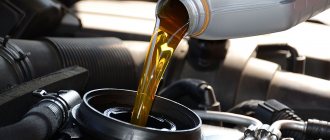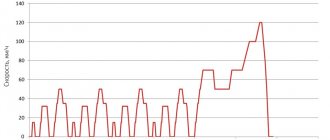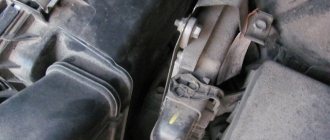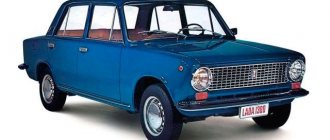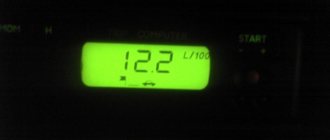Lada Priora (2020). increased fuel consumption
| List of possible faults | Diagnostics | Elimination methods |
| The air filter element is clogged | Check the condition of the air filter replacement element | Blow or replace the air filter element |
| Leaking power system | Smell of gasoline, fuel leaks | Check the tightness of the connections of the fuel system elements; If a malfunction is detected, replace the corresponding components |
| Spark plugs are faulty: current leakage through cracks in the insulator or carbon deposits on the heat cone, poor contact of the central electrode | Spark plugs are checked on a special stand at a service station. The absence of external damage and sparking between the electrodes on the inverted spark plug does not allow us to draw a conclusion about its functionality | Replace spark plugs |
| Throttle actuator malfunction | Check the travel of the gas pedal, the clearance in the drive (free play of the pedal), make sure that the cable and pedal are not jammed | Replace faulty parts, lubricate the cable with engine oil |
| The idle speed controller or its circuits are faulty | Replace the regulator with a known good one. | Replace the faulty regulator |
| The throttle valve does not close completely | The gap between the throttle valve and the walls of the housing is visible in the light | Replace the throttle assembly |
| Increased pressure in the fuel line due to a faulty pressure regulator | Check the pressure in the fuel system with a pressure gauge (no more than 3.5 bar) | Replace the faulty regulator |
| Leaking injectors | Check the injectors | Replace faulty injectors |
| The coolant temperature sensor or its circuit is faulty | Check the sensor resistance with an ohmmeter at different temperatures | Restore contact in electrical circuits, replace the faulty sensor |
| The oxygen concentration sensor is faulty | You can evaluate the performance of the oxygen concentration sensor and the reliability of its electrical circuit connections using diagnostic equipment at a service station | Restore damaged electrical circuits, replace faulty sensor |
| The ECU or its circuits are faulty | To check, replace the ECU with a known good one. | Replace the faulty ECU, restore damaged electrical circuits |
| Low compression in the engine cylinders (less than 11.0 bar): clearances in the drive are not adjusted, wear or damage to the valves, their guides and seats, stuck or broken piston rings | Check compression | Adjust the clearances in the valve drive. Replace faulty parts |
| The throttle position sensor, absolute pressure and air temperature sensors in the intake manifold or their circuits are faulty | Check the sensors and their circuits | Restore contact in the electrical circuits, replace the faulty sensor(s) |
| Increased resistance to gas movement in the exhaust system | Inspect the exhaust system for dented or damaged pipes, check the condition of the catalytic converter | Replace damaged exhaust system components |
| Malfunctions of the chassis and brake system | Check the chassis and brake system | Adjust the wheel alignment angles, replace faulty chassis parts, and troubleshoot the brake system. |
What is the fuel consumption per 100 km for the Priora?
About 7l. I have it on a sedan. This is on the highway, around the city 12 somewhere. Depends on a lot, in fact, on driving style, road load, etc. But on average in a mixed cycle I have 9.
Hello. I had experience using such a car. Well, if your car doesn’t burn and everything works like a clock, then it should be somewhere around 6-7 liters.
According to the passport, 6-7 liters per 100 km, and in the summer it’s 10 liters, in the winter up to 12 liters, in traffic jams if you drive often. I probably didn’t check it in larger versions with air conditioning.
What is the fuel consumption per 100 km of the Lada Largus?
For Lada Largus, fuel consumption per 100 km according to the passport is 10 liters. And this is an urban cycle, not a mixed cycle or anything else. We're talking about a 16 valve here.
How far can you travel by car in a day?
I live in Ufa, every year I go to Gelendzhik, sometimes even several times a summer. The first day you need to drive through Volgograd, it’s 1200 km. But if the weather is good, I reach Kotelnikovo 1550 km. And this year, without sleep, it’s 1900 km straight to Tikhoretsk. But it was generally on the brink; the passenger from the Blablacar just needed to be dropped off in Tikhoretsk. And this is not exactly a day, or rather, without sleep, because I drove these 1900 km for about 32 hours. The road is like the back of my hand; for the last few years I’ve been driving there in a Chevy. I try to keep the speed at 105-110 km. The average during the day is about 80 km, and at night it is close to 95 km/h. I make stops for food, toilets and swimming. In a word, I'm already used to it. 1200-1300 for the first day has generally become the norm for me. On the second day, such a distance is no longer possible, 1000 km. For the second day it’s already too much. I’m traveling without a shift worker, age 40. Route Ufa, Samara, Syzran, Saratov, Volgograd, Kotelnikovo, Tikhoretsk, Dzhubga, Gelendzhik. The entire route (2200 km), usually with sleep at the campsite (about 7-8 hours), takes about 40-45 hours. If I drove in a peppy car and slept right on the seat, then I could get there the fastest in 38 hours, but this is torture, not a journey then.
Niva Chevrolet fuel consumption per 100 km? yearly and suburban driving cycles
The energy consumed by the Chevrolet Niva transmission exceeds the losses caused by rolling friction in the tires. It's not very good, but it's worth noting that most light SUVs look exactly the same.
The Chevrolet Niva fuel consumption per 100 km according to the passport looks like this:
Fuel consumption of AI-95 with Euro-2 engine, l/100 km:
Highway, 5th gear (90 km/h) – 8.6;
Highway, 5th gear (120 km/h) – 11.6.
Fuel consumption of Euro-5 internal combustion engine:
Engine power remains the same, but fuel consumption per 100 km for the Chevrolet Niva increases.
To improve efficiency, you need to properly configure the transmission. Usually they talk about balancing cardans.
What is the fuel consumption of the Mazda CX 7 2.3 automatic?
If the engine capacity is 2.3 liters, then the consumption per 100 km in the city is 13-14 liters, on the highway 12-12.5 liters, combined cycle 10-11.5 liters. If the engine capacity is 2.5 liters, then the consumption per 100 km in the city is 11.8 liters, on the highway 10.7, combined cycle 8.8 liters.
Mythbusters conducted an experiment in episode 22 of season 2.
Driving a car with the air conditioning on uses less fuel than driving with the windows open.
The test took place under different conditions (88 km/h versus the initial 72 km/h). When tested at 88 km/h, fuel consumption was measured not directly, but using a computer technique based on measuring air absorption, and the test showed that the air conditioner was more economical than an open window. The test at 72 km/h consisted of driving the car until the gas in the tank was completely empty, and this test showed that an open window was more economical.
The myth was re-tested in the next season, where it was rated "partially confirmed".
Issue with double check (issue 38, season 3)
Volkswagen Passat B6 1.8 engine 160 horses how to reduce fuel consumption?
The Volkswagen Passat in the B6 body was produced from 2005 to 2010.
Unfortunately, you did not indicate the year of manufacture of your car. In any case, the old engine produces 160 hp. by default it will have higher fuel consumption.
Provided that you take care of the car and its engine is in good technical condition, you can reduce fuel consumption by changing your driving style - accelerating smoothly and stopping just as smoothly, as well as by chip tuning the engine with firmware that provides fuel savings.
Kalina fuel consumption 100km?
Fuel consumption on the Lada Kalina 1.6 is 5.9 liters per 100 km on the highway. In the city this figure is higher – 8.14 liters.
Lada Kalina 1.4 on the highway will spend 5.36 liters per 100 km, and in the city - 7.38 liters.
The second generation of cars consumes more. So, the average city consumption is 11.4 liters, but on the highway it is almost 9 liters.
1.24. Fuel economy
| GENERAL INFORMATION |
“Full throttle” or warming up the engine at idle speed increases engine wear and increases fuel consumption.
After starting the engine, immediately move away. Warm up the engine at medium engine speeds.
The restless nature of driving contributes to a significant increase in fuel consumption.
Avoid unnecessary acceleration and braking.
Drive in last gear as often as possible; when driving in the city, you can often engage 4th gear already at a speed of 50 km/h.
At speeds from 50 to 80 km/h, consumption in 4th gear is approximately 25% less fuel than in 3rd gear.
At speeds from 70 to 90 km/h, fuel consumption in 5th gear is approximately 15% less than in 4th gear.
Shift to the next gear as early as possible, and to the lower one only when the engine no longer runs perfectly.
The engine also consumes fuel at idle speed.
Already during stops of more than 1 minute, it makes sense to stop the engine. Five minutes of idling the engine corresponds to one kilometer of travel.
Forced idle mode
During forced idle mode, the fuel supply is automatically switched off, for example when driving downhill or when braking.
During this mode, do not “accelerate” or disengage the clutch so that the fuel shut-off system works to reduce fuel consumption.
Shift gears in a timely manner
High engine speeds increase wear on vehicle components and fuel consumption.
Do not increase the rotation speed to high values. Too high a speed in individual gears or stages increases wear on vehicle components and fuel consumption.
Tachometer control helps save fuel. In each gear, try to drive the vehicle at low engine speeds (approximately between 2000 and 3000 rpm) and at a uniform speed.
The higher the speed, the higher the fuel consumption. When driving at full throttle, you consume a lot of fuel.
A slight release of the accelerator pedal results in significant fuel savings without a significant reduction in speed.
If you drive at only 3/4 of the maximum speed, you save, without significant loss of time, up to 50% of fuel.
Tire pressure
Due to an increase in rolling resistance, lower air pressure in tires leads to increased costs due to increased fuel consumption and increased tire wear.
The inclusion of additional power consumers increases fuel consumption.
Additional consumers (air conditioning, heated rear window, additional headlights, etc.) should be turned off if their operation is not required.
Automatic transmission
Full throttle, kickdown, selecting sport mode and excessive manual gear shifting lead to a sharp increase in fuel consumption.
After selecting D, the transmission operates in economy mode. You can almost always drive in stage D; when you gently press the accelerator pedal, an early shift into gears occurs with economical consumption.
Roof rack, ski holders
Roof racks and ski holders can increase fuel consumption by approximately 1 l/100 km due to increased air resistance. It is recommended to remove them when not in use.
When buying a car, the owner looks at the characteristics of the car, including how much he will have to spend on gasoline. If we talk about the Lada Priora, the fuel consumption indicated in the description, according to car enthusiasts, does not fully correspond to the actual indicators. Therefore, it is worth comparing the numbers, taking into account additional factors and fully understanding the matter.
Consumables and operating modes
It's no secret that the fuel consumption of the Priora, as well as other cars, increases if the engine operating mode does not correspond to the optimal temperature (from 98 to 108 degrees Celsius). At low temperatures, an enriched mixture is injected into the mechanism to warm up the internal combustion engine. This leads to a 20% increase in consumption at temperatures below 80 degrees Celsius. An overheated engine produces a discharged fuel mixture, it becomes lean, which results in a loss of power, which is compensated by additional consumption. Therefore, those who warm up the engine for a long time by moving long distances often consume less gasoline than those who move in short bursts.
The amount of the receipt at the gas station may depend on what fuel you use. If it differs from that recommended by the manufacturer (for Prior it is an unleaded version), then get ready to pay more. Get ready to fork out money if you use incorrectly selected oils, which, with increased viscosity, increase gasoline consumption for the Priora by 15%. And of course, those who do not turn off the engine during long stops will always pay more.
Whatever economy mode you choose, in some cases, excessive fuel consumption cannot be avoided. These include: driving with sudden acceleration and braking, winter (due to tires, use of a stove, etc. there is almost always an increase of 10-12%), driving the car on bad roads where slipping, slipping, and using a lower gear are observed . In addition, it is worth taking into account the own weight of one or another Priora modification, because the more massive the car, the more energy it requires to move.
Loading …
Lada Priora 1.6 MT 98 hp
Features of the package
Another power unit from the line of engines of the basic Lada Priora is the same four-cylinder unit with a volume of 1.6 liters. Its significant differences are that the number of valves has been doubled - now there are 16. In turn, this has affected the increase in power from 90 to 98 horsepower. The maximum speed of a car with such a unit installed under the hood is 183 km/h, while acceleration to hundreds of kilometers will take 11.5 seconds, which is one and a half seconds faster than 90 horsepower. Fuel consumption in the urban cycle has also increased - so, now 9.8 liters are spent per 100 km, and 5.6 liters on the highway.
Owner reviews about consumption
- Pavel, Astrakhan. Before this Priora, I drove the ninth VAZ model for a long time. I decided to take something newer and inexpensive. The car (I took a used one from 2007 with 97 thousand mileage) is very good, even because I, a tall person, can sit in it comfortably. The interior is not noisy, but its build quality leaves much to be desired. Yes, and the gears are difficult to switch, especially 3rd. Consumption on average is 7.5-8 liters.
- Maxim, Tambov. Lada Priora 1.6 MT 2008. The car is new and I recently purchased it. So it’s too early to talk about the pros and cons. But the first thing that caught my eye was the good design and engine. Its consumption per hundred is about 8 liters. Among the shortcomings, I noticed that the trunk lid was knocking and there was a strong creaking noise in the cabin. I'm guessing it comes from the brakes.
- Ramil, Belgorod. I drive relatively recently, I bought a 2009 car second-hand. First impressions are good. The only thing is that the engine makes too much noise, and the doors have poor sound insulation. On a dirt road, the car jumps a lot, apparently due to the harsh suspension. Consumption in the city is 9-10 liters, on the highway 6-7 liters. Overall happy with the car.
- Denis, St. Petersburg. Priora 1.6 MT 2008. Of course, for that kind of money they could have tried to make a better car. The first serious problem I encountered was that after 9,000 km the heating system stopped working. In addition, it was possible to install air conditioning in cheaper trim levels. Consumption at the moment the computer shows 7 liters per 100 km.
- Andrey, Chelyabinsk. Our people still don’t know how to make cars. Over a period of 100 thousand km, I changed the steering rack twice. I repaired the box because it started to lose the first two speeds. The interior is put together disgustingly - all the control buttons are already sunken, just like the seats. The only normal thing is consumption - 7-8 liters per 100 km. It's time to switch to a foreign car.
Theoretical indicators
The factory specifications of the Priora indicate the fuel consumption of this car. But the data is averaged and does not reflect the full picture. The manufacturer claims that this 16-valve machine with a power of 98 horsepower and a manual transmission “eats” 6.9 liters per hundred kilometers.
And at the same time, the flagship model, which drives an automatic transmission with five gears, consumes 6.6 liters per 100 km with 106 horsepower. But a variation of a car without an automatic transmission with 106 horsepower “eats” 6.8 liters, covering the same distance. All calculations of Lada Priora costs per 100 km are made under mixed mode conditions.
The table shows the consumption of a 16-valve Lada Priora with a 1.6-liter gas tank while traveling along a highway or a busy city.
| Mode | 98 l. With. with MT | 106 l. With. with 5AT | 106 l. With. with MT |
| Highway (outside the city) 90 km per hour | 5.5 liters per hundred kilometers | 5.5 l per 100 km | 5.6 liters per 100 km |
| Around town | 9.1 l/100 km | 8.5 liters/100 km | 8.9 liters/100 km |
| Mixed | 6.9 l. per 100 km | 6.6 l liters/100 km | 6.8 l/100 km |
Based on the indicators, we can conclude that the highway is the most economical mode. Gasoline consumption on the Priora, regardless of power and gearbox, is noticeably lower.
The 8-valve Priora 1.6 MT produces 90 horsepower on a 100-kilometer country road using 6.2 liters. While it will travel the same amount on city streets, it will already consume 8.8 liters.
But 1.8 MT 123 liters. With. on a long, flat path it will spend 5.4 liters, driving a hundred kilometers, and on busy streets the same distance will require burning 9.8 liters of gasoline.
What is the fuel consumption of the Lada Priora at idle speed?
Of course, Russia, over its more than thousand-year history, has enough examples for well-deserved pride. However, the auto industry is clearly not one of them. Lada Priora is considered one of the most controversial achievements of the automotive industry of the Russian Federation. On the one hand, it was well received both by customers, as evidenced by excellent sales at the time of release, and by representatives of the automotive press. On the other hand, the joy of the owners knew no bounds only because of the relatively low cost of this vehicle. As soon as all its shortcomings, characteristic of most cars from the Togliatti company AvtoVAZ, were revealed, Priora began to be hurled with choice curses.
Features of consumption depending on the gearbox
The automatic Lada Granta consumes more fuel, since the manual gearbox is controlled by the driver, and the automatic switches independently, with a slight delay. For a Lada Granta with a manual transmission, the gear engaged when driving is very important. By analyzing his daily journey, the driver can determine the real gas mileage of his car. According to reviews from Lada Granta car owners, it turns out that the following is consumed per 100 km:
- in the city - automatic transmission 9-12 l, manual transmission 7-11 l;
- on the highway - automatic transmission 8-9.5 l, manual transmission 6-7 l.
In winter the indicators are maximum, in summer they are minimum. Thus, a tank volume of 50 liters allows you to travel more than 500 km. In city mode, drivers are forced to combine aggressive and quiet driving, hence the average gas consumption of a run-in Lada Granta is 8 l/100 km. Using engine braking, choosing the right gear (on a manual transmission) and driving only in the far right lane behind public transport will help reduce fuel consumption by 1.5-2 liters. On a suburban highway, when driving smoothly on a flat road surface, values of 5 liters are observed. However, with sharp braking and a quick start, with constant overtaking, the consumption increases to 6-7 liters.
For your information
- When estimating the actual amount of fuel consumption, it is advisable to follow the generally accepted method: fill the tank full, reset the odometer, drive a certain number of km and fill the tank full again, while simultaneously noting the amount of liquid filled. The required value is found by dividing liters by kilometers traveled.
- The on-board computer in mixed mode, after resetting, starts counting from 19.9 l/100 km.
- To visually assess consumption, you should “monitor” the current indicator in 4th and 5th gears during quiet driving.
Winter
It's a difficult time of year for cars. Priora fuel consumption can vary significantly. The 16 valve Priora consumes more in winter. Firstly, when the engine is not warmed up, the gasoline consumption of the Lada Priora will be higher.
Secondly, the increased complexity of roads that require the car to drift also increases fuel consumption. Thirdly, speed. The slower the car moves, the more gasoline it uses.
Lada Priora, which has 16 valves, is overall more economical than other cars with similar technical characteristics. In addition, if you wish, you can always convert it to gas consumption and significantly save your family budget.
In winter, any car more often requires filling the tank. Fuel is spent on heating the interior, braking, turning and other elements of driving, which turn into stunts when there is a lot of snow on the street, the number of accidents increases, they appear out of nowhere, and traffic jams suddenly disappear. Lada Priora moves confidently in any weather, because it has a very convenient body shape and dimensions. This is what will help reduce fuel consumption.
Driving around the city requires a special driving style. Having developed it, each driver will take care of the budget and expenses. It should be remembered that a sudden change of direction, braking and speeding up is not only a risk, but also a waste of fuel. If you find yourself in a traffic jam, it is better to turn off the engine. More effective ways to increase the savings rate in winter have not yet been invented. But by following these recommendations, you can achieve a lot. Worth a try.
Can Light Priora consume less fuel?
This is an economical car.
Firstly, an interesting fact is that fuel consumption may depend on the color of the car. The ubiquitous Americans conducted tests, during which it was found that light-colored models consume 1.2% less fuel, because at high temperatures (in the sun), the temperature in the interior of a silver-colored car is 5 degrees lower than in a black model . Therefore, it takes 13% less energy to cool the interior.
Lada Priora, unlike its domestic predecessors, is equipped with an air conditioning system, so the color of the car in the southern regions of Russia may play some role. What specific equipment is in the car - Taiwanese (Panasonic) or Korean (Halla) - can be found out from the specification.
According to user reviews, both lines of cooling devices work efficiently, so it may indeed turn out that a car in the color “white cloud”, “snow queen” or “poplar fluff” will consume less fuel than in a car with a color scheme in the “space” style, “ Panther", "Sochi" (sea green) or "port" (plum).
The increase in fuel consumption due to the use of air conditioning is about 3%, which is not always noticeable. But in hot weather, when the cooling is operating at full capacity, the engine takes more energy to operate the air conditioner, which is why there is an increase in consumption of up to 10-12%.
Technical reasons for increased fuel consumption
Despite the fact that VAZ has stepped far forward in improving its products, many unresolved problems remain. And some of them have a direct impact on the amount of gasoline consumed.
Injector diagram (fuel supply to combustion chambers)
All influencing factors can be divided into “hardware” and “software”. This classification was the result of the use of an injection engine, as well as the abundance of sensors in the car’s design.
Incorrectly selected fuel
It is recommended to fill AvtoVAZ engines with 95-grade gasoline only. Only then will the engine control system begin to correctly calculate the parameters for preparing the fuel mixture. Therefore, when using gasoline with an octane number below 95, fuel consumption will increase and foreign vibrations may appear in its operation.
Electronic system errors
They can be considered one of the simplest situations, since they can be corrected by simply contacting a specialized service center. Problems of this kind arise for the simple reason that some sensors that are used to prepare the working mixture begin to function incorrectly.
Diagnosis of car electronic systems
In particular, we are talking about
- temperature sensors,
- throttle position sensors,
- as well as mass air flow.
In the latter case, its breakdown may be due to the fact that the air filter has not been changed for a long time. And, of course, incorrect readings can result from false information from the oxygen sensor, which is also simply called a lambda probe.
All this can lead to both the preparation of a “lean” and “rich” mixture. As a result, power may be lost or fuel consumption may increase. A malfunction can be detected by diagnosing each sensor separately.
Fuel system pressure
In Fig. car fuel frame and receiver
This is another common breakdown. The fact is that the pressure level can be too high or low, although the second option is much more common. This can be determined when the engine loses power and you have to drive at higher speeds to maintain the desired dynamics. This all significantly increases fuel consumption.
If you have problems with the fuel rail, the car may not start.
Injector problem
If you do not monitor the condition of the power unit, this will lead to shortcomings in its operation. Most often, this concerns contamination of the injectors, which is followed by poor supply of the working mixture, so that the engine begins to “triple”, and you try to compensate for this by increasing the speed.
Catalyst destruction
Similar results occur when the catalyst burns out or even breaks down. Without going into detail about the specifics of this situation, we can simply conclude that if the catalyst is contaminated, a “rich” mixture will form. After this, additional heating of the catalyst occurs, reducing its service life and reducing engine power. Fuel consumption will be maximum.
Motor temperature
In addition to all of the above, it would be a good idea to constantly monitor the engine temperature. If it is above 103 degrees, then the mixture will not be of sufficient quality. The engine will begin to operate on a “lean” mixture, reducing its power and increasing gasoline consumption.
The main drawback is that the instrument panel on the Lada Granta does not have a real-time indication of the engine temperature, read how this can be fixed here.
If the engine has not yet warmed up, this leads to an increase in consumption due to the “enrichment” of the mixture. The level of overspending reaches 20 percent. In most cases, the cause must be found in the thermostat.
Incorrect engine operation
Increased fuel consumption may be due to a “broken” engine. That is, the engine is worn out. The main symptoms of engine wear will be:
- There is no compression.
- Maslozhor.
- Other.
- bad dynamics
- erratic engine operation
Air filter dirty
And, of course, we must not forget that if air flows poorly through this filter, the effect of “oxygen starvation” will begin. This will entail a significant excess of gasoline consumption.
How to reduce consumption using “economical firmware”?
The only advice would be not to perform these procedures if you have a valid car warranty. In addition, only professionals should do this. If you do this yourself, then you need to first study this topic in detail.
Components in which malfunctions increase gasoline consumption
Fuel pressure regulator VAZ 2110 8 valves causes of malfunction
What element can cause unstable fuel pressure, which, in turn, leads to increased consumption? As a rule, this is either a fuel pump (worn out under the influence of tiny particles from low-quality fuel), or a clogged fine filter, or a mesh in the fuel pump. The electronic brain of the car in this case is based on constant pressure, and when it decreases there is no possibility of compensation even when maximizing the time for injection of the mixture, so fuel consumption only increases.
On Priora injection engines, an increase in gasoline consumption may be due to contamination on the injectors themselves. In this case, the quality of atomization and the shape of the spray “torch” are disrupted, which results in a decrease in efficiency, the appearance of “triple”, and the useless burnout of part of the fuel in the collector.
Reasons for wasting fuel
What other component of the car can cause additional costs at the gas station? It is worth paying attention to possible flaws in the operation of the automatic transmission, where the locking clutch may, due to a malfunction, prevent you from switching to a higher gear, which is the most economical. Do not forget about such an option that is available on Priora cars today as “cruise control”
What effect does it give? This system maintains vehicle speed automatically. During operation of the mode, there is a quick transition to a higher gear and the movement by inertia is actively used, which gives significant savings on gasoline for some motorists
Do not forget about such an option that is available on Priora cars today as “cruise control”. What effect does it give? This system maintains vehicle speed automatically. During operation of the mode, there is a rapid transition to a higher gear and the movement by inertia is actively used, which gives significant savings on gasoline for some motorists.
Modifications and technical characteristics
The Lada Priora received the latest changes and restyling in 2013. Then cars with gasoline engines with a power of 87, 98 and 106 hp began to roll off the assembly line. The table below shows a comparative description of the main parameters of Lada Priora vehicles.
| Main characteristics | ||||
| Modification | 1.6MT | 1.6 MT 98 hp | 1.6 MT 106 hp | 1.6 AMT |
| Model year | 2013 | |||
| Body type | Sedan | |||
| Number of doors, pcs. | 4 | |||
| Number of seats, pcs. | 5 | |||
| Country of assembly | Russia | |||
| Performance characteristics | ||||
| Type of gasoline | AI-95 | |||
| Acceleration time to 100 km/h, s | 12,5 | 11,5 | 11,4 | |
| Maximum speed, km/h | 176 | 183 | ||
| Consumption (urban cycle), l/100 km | 9,0 | 9,1 | 8,9 | 8,5 |
| Consumption (highway), l/100 km | 5,8 | 5,5 | 5,6 | 5,5 |
| Consumption (combined cycle), l/100 km | 7,0 | 6,9 | 6,6 | |
| Dimensions and dimensions | ||||
| Length, m | 4,350 | |||
| Width, m | 1,680 | |||
| Height, m | 1,420 | |||
| Ground clearance, m | 0,165 | |||
| Front track, m | 1,410 | |||
| Rear track, m | 1,380 | |||
| Wheelbase, m | 2,492 | |||
| Turning diameter, m | 11,6 | |||
| Volume | ||||
| Fuel tank volume, l | 43 | |||
| Engine | ||||
| Type | Petrol | |||
| Number of cylinders / Type of arrangement | 4/Inline | |||
| Power, hp/rev | 87/5100 | 98/5600 | 106/5800 | |
| Working volume, cm³ | 1596 | |||
| Torque, Nm/rev | 140/3800 | 145/4000 | 148/4200 | |
| Transmission | ||||
| Drive unit | Front | |||
| Gearbox type | 5-speed manual | 5-speed automatic |
Why does my Lada Granta consume a lot of fuel?
On specialized forums you can find messages from people who complain that their Lada Granta, according to the on-board computer in the city, consumes 12, and sometimes 13 liters of fuel per 100 kilometers. Why then, one wonders, does one car consume 7.4 liters, and the other 12? The answer is very simple. To more accurately measure fuel consumption, you need to drive at least a thousand kilometers and check the consumption, which is called “by receipt” or “from light bulb to light bulb.” How to do it? We are waiting for the fuel remaining lamp to light up - this means that you have less than 7 liters of fuel in the tank. We fill the tank full or the required amount of fuel, measure the mileage and wait until the fuel remaining lamp comes on again. In this way we refuel and measure until we travel a thousand kilometers. Next, we calculate the consumption using a simple formula: (Amount of fuel / Mileage) * 100 = average consumption.
Example: we filled up with 100 liters of fuel and drove 1000 kilometers. Our average consumption will be as follows: (100/1000)*100 = 10 liters per 100 kilometers.
Among other things, urban driving style will vary greatly depending on the congestion of the roads on which the car is driven, the duration of the trip, warm-up time, and the length of time it is parked with the engine running. Don't forget, idle speed tends to infinity. And even if, based on the results of the calculations, you received a result of over 10 liters of fuel per 100 kilometers of city driving, do not despair, this does not indicate a malfunction of the car’s systems. To check the serviceability of the systems, you need to carry out a simple test: reset the on-board computer, drive out onto an open highway and drive 5-10 kilometers at a constant speed of 80-90 km/h. If the result of the test is a consumption of 4.5-5.5 liters, then all the systems of your car are working properly, and the reason for the “great appetite” of your car in the city lies in the driving style, traffic congestion and the duration of the trips themselves.
Also, do not forget that the plant regulates fuel consumption indicators only when using fuel with an octane rating of at least 95. When using any other fuel, the manufacturer determines the fuel efficiency of its engines.
This question can be most fully answered by the following videos, which will show the summer and winter fuel consumption of the Lada Granta.
Winter:
Summer:
What kind of gasoline should be poured into the Lada Largus, choose between 92 and 95
Many Lada Largus owners wondered what kind of gasoline to pour into their favorite “iron horse”.
You can often come across this question on various automotive forums, but no one can give a clear answer. Let's try to consider and come to a conclusion, what kind of gasoline is needed for this car?
Recommendations from the AvtoVAZ plant
Standard gas pump at a gas station
Which of these will we choose for Largus?
According to the service book and manufacturer's recommendations, Largus must be filled with fuel with a medium or high octane number. So, the question arises, what kind of gasoline should be poured into the tank - AI-92, AI-95, AI-98, or the Premium and Euro varieties? In the same manual about the fuel system it is written that it is not lower than AI-95. This is due precisely to the effect on the fuel system, which better perceives this particular marking.
Renault engine manufacturer's recommendations
The factory's recommendations are duplicated on the gas tank flap cover (only 95 and 98)
Lada Largus gas cap flap indicating the type of gasoline
Since the Largus has a Renault engine, you should listen to this manufacturer when choosing gasoline.
An exact definition was found in the service book for the K4M and K7J engines. The fuel system must be filled with gasoline marked at least A-95E.
Gasoline consumption on the dashboard of Lada Largus
To reduce consumption, the manufacturer recommends using only 92 gasoline.
This fuel is designated AI-95 Euro on the domestic market.
Expert recommendations
In 2014, this car was tested on different types of fuel. Three cars with the same characteristics, into which AI-92, AI-95 and AI-98 were poured. Each of them was tested for different indicators.
When using AI-98, the engine overheated too much and the cooling fan could not cope. Therefore, experts noted that this brand of fuel is not very suitable for use in Lada cars.
When using AI-95, there was a noticeable increase in dynamics and a drop in consumption compared to AI-92. Thus, experts noted that the ideal option is to use this particular brand of fuel.
Motorists' experience
Experience says it's 95!
Based on the experience of motorists, we can say that AI-95 becomes the optimal option for use. After switching to this brand from AI-92, the dynamics noticeably increased, and the consumption decreased by almost 25%, which cannot but please the owners.
Also, auto mechanics note that when using AI-95, there is less deposits on the walls of the combustion chambers, and the fuel system becomes clogged and fails much less often. Therefore, it is recommended to fill Largus with this type of gasoline.
Economical driving
Fuel consumption at idle speed. How much per hour is considered normal?
Winter has come and now many cars “start” according to the alarm time (banal programmable autostart). Also, many write that it is precisely because of such “warming up” that a large amount of fuel is wasted. That is, the consumption at idle is simply huge (increases by almost 50%)! BUT is this really so? How much does the car consume per hour with such idle warm-ups? Let's find out + as usual video version...
Of course, the colder it is, the more difficult it is for the car to start and operate for the first 3–5 minutes; then the system warms up and consumption drops. But it becomes clear that in any case there is a cost, but not as huge as many people write.
Lada Priora 1.8 MT
Information from the manufacturer
In 2014, sales of the Lada Priora car began, the manufacturer of which is. The new version is equipped with an engine with a displacement of 1.8 liters and a power of 123 horsepower. Acceleration time from zero to hundreds has increased significantly compared to previous models - it is now 10.0 seconds. The maximum speed to which the updated Priora can be accelerated is 190 km/h. Consumption is 9.8 liters in the urban cycle and 5.4 liters on the highway.
The situation with real gasoline consumption
- Mikhail, Peter. Lada (VAZ) Priora 1.8 MT 2014. Overall, I’m happy with the car. For such little money I got the equipment I wanted. In terms of breakdowns, I haven’t encountered any yet. Consumption remains on average at 7.5 liters. I would like, of course, better sound insulation. Yes, and the seats could be replaced, since the standard ones are not of the best quality.
- Sergey, Suzdal. The car, although produced in 2014, has a lot of shortcomings. After the first 10,000 km, the suspension and generator had to be changed. I also redid the sound insulation, or rather, installed it, since there is almost none in the Priora. The only good thing about it is the engine. Its consumption is economical. On the highway at 90 km/h it consumes 5.5 liters. In the city, no more than 9.5 liters are spent.
- Andrey, Moscow. Priora is a good car. Price-quality-equipment correspond to each other. The engine is good and grippy. At the same time, its consumption is economical, on average 7.2-7.5 liters per 100 km. Of course, I consider these strange creaks in the cabin to be a big minus. Apparently the noise here is of poorer quality. Plus the quality of the paint is poor - there are too many chips.
- Vladimir, Sevastopol. Lada (VAZ) Priora 1.8 MT 2014. The overall impression of the purchase is the worst. I don't think she has any advantages. A year after the purchase, my body began to rot in several places. As for the interior, the trunk opening button should be recessed so that it does not open while driving by pure accident. The engine is noisy, eats a lot - 9-10 liters.
- Nikolay, Izhevsk. Of everything in the Priora, the only normal thing is the 1.8 liter engine. Powerful and economical. Consumption is a stable 10 liters in the city, 6 liters on the highway. Everything else: sound insulation, painting, interior assembly, seats - as always in our automotive production, at the lowest level.
In 2021, it was decided to stop production of the Lada Priora, but soon they decided to postpone the production stop to 2018. So, in 2021 a new version of the Lada Priora will appear. In terms of significant modifications, we can highlight the modified design of the car. This mainly affected the front of the car. As for the power units, the same 1.6-liter ones with eight and sixteen valves remain. Also, in addition to the 5-speed manual, the new Priora will be equipped with a robotic automatic transmission.
It's rare that a car enthusiast doesn't want to achieve a real reduction in fuel consumption. We'll tell you how to do this without buying miracle devices that turn out to be just scams.
Lada priora
The Lada Priora is equipped exclusively with gasoline engines of the following volumes: 1.6 liters with a power of 90, 98 and 106 horsepower, 1.8 liter with a power of 122 and 130 horsepower. The engines are combined with a five-speed manual or five-speed robotic transmission. The maximum achievable speed of the car is from 190 to 196 km/h.
- Ivan, Orenburg. Choosing a car took quite a lot of time, I thought about Daewoo Lanos, Cherry Amulet and Priora, but in the end I settled on it, the price was right. I have a 2009 model, 1.6 l, 90 horses. The car is very average in terms of assessment: some are good, some are unfinished. But I'm driving it for now. The consumption is small, 6-9 liters.
- Oleg, Tver. Lada Priora 2008, not bought new. Before her there was a “nine”. Priora attracted me with its low price and good build quality. I am quite tall, but the seat in the car is very comfortable. Noise insulation is good, but speed shifting is not very good. Fuel consumption is from 6 to 10 liters.
- Timofey, Belgorod. The domestic manufacturer, of course, is taking steps to improve cars, but we are still very far from reaching a good level. Slowly, one after another, various spare parts become unusable. There is no need to talk about sound insulation at all. Consumption is low, which is good: 56 liters on the highway, 8-9 liters in the city. The car was produced in 2020, with a 1.6 liter engine.
- Pavel, Syzran. Lada Priora 2009, 1.6 l, 98 hp It seems to me that I overpaid, but I was already tired of looking for a car and took what I had. The heating turned off after ten thousand miles, the creaking did not go away from the first day, the engine is so noisy that you can’t hear anything. Average consumption according to instrument readings is 7.5 liters per hundred.
- Gregory, Shakhty. My husband bought me a 2007 Priora, 1.6, manual. If you compare it with other VAZ creations, then, of course, the Priora is a cut above, but in no case can you compare it with its Western or Japanese counterparts. The complete lack of sound insulation is especially annoying. Consumption is good: 6 liters on the highway, 9 liters in the city.
- Dmitry, Stavropol. How I ended up acquiring this bucket of bolts, I don’t know, because there were good options for my money. I haven't tinkered with the mechanisms for a long time! Everything that can break breaks, there is no noise at all, the 1.6 liter engine is weak for me, but it needs a lot of fuel - 10-11 liters in the city. On country highways there were never less than eight.
- Afanasy, Moscow. I have a 2021 Priora, 1.6, manual transmission. Good appearance and high-torque engine. But the Shumka is not good at all, everything inside creaks to the point of a headache. Consumption is 7 liters on a country highway, 9 liters in the city.
- Roman, Samara. Lada Priora, 1.8, manual, 2021. In my day, I bought a good car, bought it new, and had no breakdowns in a year. Yes, there are shortcomings, but I don’t know why many people criticize this model, I like it. Consumption is low - 6-10 liters per 100 km.
- Anatoly, Kaliningrad. Priora 2021, 1.6, manual. In my opinion, it is an excellent car, superior in some respects to its foreign counterparts. We like the car so much that we have already decided to buy the same one for our wife. Minimum consumption - 6-9 liters.
- Anton, Kostroma. I bought the car second-hand, but in good condition. I really like the Lada Priora, I have almost no comments. The stiff suspension is compensated by the quality of the native roads. The interior is comfortable, but I would like more space. A 1.6 engine with a manual uses an average of 8-9 liters of gasoline.
- Maxim, Nizhny Tagil. My Priora was not new when I bought it. The 2009 model hasn't had time to wear out yet, so I'm happy. If you do not take into account the constant noise of the engine, then everything else is fine. Because of the stiff suspension, on the dirt road you feel like you’re at a horse race. Consumption on average is 8 liters of gasoline.
- Roman, Moscow. The 2021 Lada Priora seems to be modern, but there are almost more disadvantages than advantages. The suspension is stiff, the alternator has already been replaced, and the noise in the cabin is very loud. But the engine is surprisingly good, the 1.8 liter engine pulls quite powerfully and consumes little - 5-6 liters on the highway, 9-10 liters in the city.
- Daniil, Perm. Lada Priora fully corresponds to price/quality indicators. Those who want everything at once should have bought expensive/foreign. I don't like the paint job and the extraneous noises in the cabin, but otherwise it's a pretty decent car. Consumption on average is 7.5 liters.
Reasons for increased fuel consumption of Lada Vesta
The cost of gasoline consumption today is taking a significant toll on your wallet. It’s rare that a Vesta owner won’t notice that gas mileage has increased. High fuel consumption often indicates a car malfunction, but this is not always the case. Let's look at the reasons for the increase in gasoline consumption following the example of the Lada Vesta Cross SV.
On the mechanics, everything depends on the driver’s experience, but even incorrect gear shifting will increase the car’s fuel consumption. The engine speed has increased, the gearbox continues to transmit torque in the previous gear, no shifting occurs, and naturally more energy and gasoline are consumed, respectively. With the right gear, at the right speed, the car would have already gone further, so the fuel is wasted.
The robot automatically changes gears; it turns out that 100 km for a manual transmission is more expensive than for a manual transmission. With a robotic gearbox, the station wagon can more easily withstand sudden accelerations and braking, which characterize city trips. On the highway there are always high gears and high speed and consumption is 1.5-2 liters lower. But the route is different - ups and downs, serpentines and a flat road. A long uphill climb puts more stress on the engine, which increases the amount of gasoline used.
Switched on energy consumers take charge from the engine and affect the amount of gasoline burned. Moreover, this applies not only to the air conditioner or subwoofer, but also to ordinary car headlights.
In winter, fuel combustion increases due to the constant inclusion of additional equipment, due to the engine warming up before driving.
Uneven tire pressure increases the load on the internal combustion engine. Tires that are too narrow or too wide can also affect fuel consumption.
